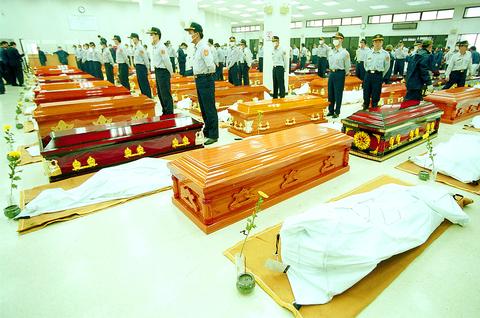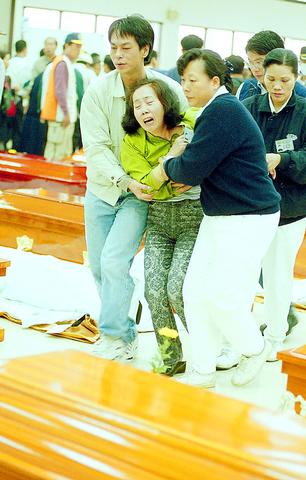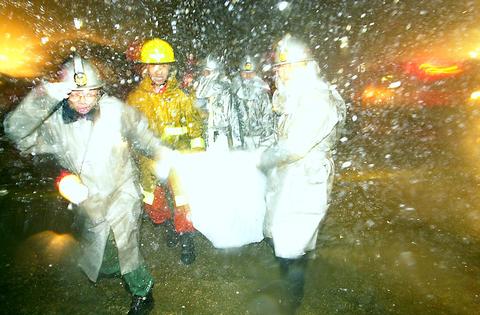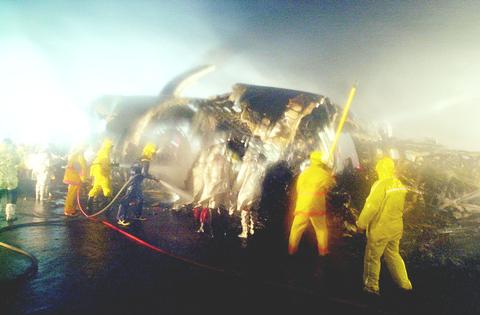After the worst of the tragedy seemed over, the pain was no less acute for the victims and their relatives. It was the beginning for them. The victims were survivors, but very few felt "lucky" for being so.
They sat burned and bruised, physically battered and mentally overwhelmed. Just a day after the crash, some survivors were coming to terms with the events of their narrow escape. And the realization of how close they had come to death settled deeper upon them.

PHOTO: CHIANG YING-YING, TAIPEI TIMES
SURVIVOR: Mike Yu

PHOTO: CHIANG YING-YING, TAIPEI TIMES
"I can only use the word grievous to describe what I saw," said Mike Yu (
Yu was lucky. He escaped with only light burns on his feet and hands, and he was soon transferred out of the Burn Center at Chang Gung Memorial Hospital (長庚紀念醫院) in Linkou (林口). But his mental burden is heavy. "I really wanted to help other passengers if I could," he said.

PHOTO: GEORGE TSORNG, TAIPEI TIMES
When Singapore Airlines flight SQ006 burst into flame Tuesday night, there were 179 people on board. Seventy-nine died instantly. Two more died later in the hospital. The cause of the crash is still under investigation.

PHOTO: GEORGE TSORNG, TAIPEI TIMES
During the two days in the hospital, Yu refrained from watching TV or reading any news related to the airplane crash. "I used to be a couch potato. I loved to watch TV, you know. But now I don't want to," he said. "I don't want to think of the recurrences of the tragedy."
The 46 year-old Yu, an executive in an automobile company, has had time to deeply reflect on his life over the past few days. "I have done so little for society in the past," he said. "In the future, I will try as hard as I can to benefit others."
SURVIVOR: Wei Chih-an
"Hey, how do you like my Halloween outfit?" said Wei Chih-an (魏祈安). Bandages covered his face and hands. He was greeting a friend visiting him in the Burn Center at Chang Gong Hospital and trying too bring a little levity to what was clearly a bleak time.
"I was probably among the first 20 passengers running out of the plane," he recalled. "I felt a tremor, something similar to that when the wheels of a plane hit the ground during landing." He felt this tremor twice. And then the next thing he saw was the sky, up above, raining and windy. He was still in his seat.
"Run! Quickly! Run!" he heard someone say. "I immediately got out of my seat and began running. After running for about 20, 30 meters, I thought it was far enough and I slowed down to walking."
"Keep running, the plane may explode!" he heard from a flight attendant. So he ran again, with a dozen passengers ahead or behind him. They crossed the trench separating runways and moved onto the tarmac again.
The running was quiet, compared to the very first moments of the crash, when people screaming, yelling, families calling each other's names. "No one was talking. I had not a second to think of anything. I just kept running," Wei said.
Wei is a US citizen from Taiwan. He runs a small store in Los Angeles with his wife. Last week, Wei came back to Taipei to see his 70-year-old father. The accident has prolonged his stay in Taipei. Because 5 percent of his body is covered with first-degree burns -- he didn't realize he was wounded until he reached the tarmac -- he will stay for another month. "But I am very glad I survived, which is the most important thing for now.
"Absolutely," says a nearby friend, nodding and patting his shoulder.
Asked if he would fear flying in the future, the 51-year-old responded in a practical tone: "I cannot have this fear. I still need to go home to Los Angeles."
SURVIVORS: Father Cheng Wen-teh, sons Cheng Tze-heng and Cheng Tze-hsien
"I asked their daddy to take the kids abroad to get a better education. ... Who could know things would turn out this way?" said Lee Chih-chen (李琦珍), sobbing.
She is the mother of seven-year-old Cheng Tze-heng (程子恆) and six-year-old Cheng Tze-hsien (程子賢) and the wife of Cheng Wen-teh (程文德), who was taking the boys to Belize so they could attend elementary school. The parents hoped their children would learn Spanish and English there.
"The airplane was so hot! So hot! Where is daddy?" cried Tze-hsien, when he and his brother were sent to the Burn Center.
Their father, by saving the two, suffered burns on nearly 40 percent of his body, including his chest, back, face and hands. He now has a tube down his throat to help him breathe and so is unable to speak.
"Daddy was trying to protect us with his body, and he also removed the crashed chair to help me get out of my seat," said Tze-hsien. The boy has his head and ears covered with bandages. His aunt said he had been shivering all day. "He said he's not going to fly anymore!" the aunt said.
The two boys have burns covering 5 to 8 percent of their bodies. When the family went to visit Cheng Wen-teh, the father, Cheng, although unable to speak, was clearly glad to see them and tried to get out of bed despite the seriousness of his injuries. "Don't move, Cheng Wen-teh! The kids and I already saw you. And we know you saw us, too! Stay still, ok? You'll worsen your wounds," Lee said.
Lee said she did not know what to do next. It will take at least a month for Cheng to recover while in hospital.
As for the kids, the plan to study abroad is sure to be put off. "I don't know if the brothers want to go abroad or not," she said.
COPING: Chang Gung Memorial Hospital
By 3pm on Wednesday, most of the victims brought to the Chang Gung Memorial Hospital (長庚紀念醫院) in Lin Kou (林口) had been cleared from the emergency room. All that remained was an information board giving the names and bed numbers of those who remained. An "unidentified foreigner" was listed and scrawled in black ink, on the same line, was the word "dead."
Most of the patients had been transferred to the hospital's Burns Center, on the second floor, where a line of volunteers from the Foguangshan Buddhist organization stood outside chanting prayers for victims, sending up an eerie base note in the antiseptic corridor.
Around 4pm, a covered gurney was wheeled out from behind the tightly closed steel door of the center, forcing a silence onto the few people lingering outside. A man in a dark suit and a fixed smile, an undertaker, took charge of the body. People in the corridor bowed their heads. A cream colored sheet with a tasseled fringe was laid over the stained sheets covering the body and it was wheeled away. The drone of the Buddhist chanting continued, emphasizing the somber moment.
Inside the burns unit, Steven Courtney, a biologist from the UK, noted that the accident could have been much worse. "When we arrived [from Bali], the plane was full. There would have been much more panic and it would have been difficult to escape. As it was, the plane was only one-third full [when we left.]"
Seated to the rear of the plane, Courtney recalls a fireball rushing towards him, then pushing himself forward to the central area, where he escaped through a great break in the fuselage of the plane.
Courtney had second and third degree burns covering 20 percent of his body, mostly on his back and thighs. Confined to his bed, Courtney fretted over the lack of mobile phones, which are banned because they might interfere with the hospital equipment. He said he only wanted to keep in close contact with his wife, who was being put up at a hotel by Singapore Airlines. "I could be here for two weeks," he said. "All I really want to do is get home."

The canonical shot of an East Asian city is a night skyline studded with towering apartment and office buildings, bright with neon and plastic signage, a landscape of energy and modernity. Another classic image is the same city seen from above, in which identical apartment towers march across the city, spilling out over nearby geography, like stylized soldiers colonizing new territory in a board game. Densely populated dynamic conurbations of money, technological innovation and convenience, it is hard to see the cities of East Asia as what they truly are: necropolises. Why is this? The East Asian development model, with

June 16 to June 22 The following flyer appeared on the streets of Hsinchu on June 12, 1895: “Taipei has already fallen to the Japanese barbarians, who have brought great misery to our land and people. We heard that the Japanese occupiers will tax our gardens, our houses, our bodies, and even our chickens, dogs, cows and pigs. They wear their hair wild, carve their teeth, tattoo their foreheads, wear strange clothes and speak a strange language. How can we be ruled by such people?” Posted by civilian militia leader Wu Tang-hsing (吳湯興), it was a call to arms to retake

This is a deeply unsettling period in Taiwan. Uncertainties are everywhere while everyone waits for a small army of other shoes to drop on nearly every front. During challenging times, interesting political changes can happen, yet all three major political parties are beset with scandals, strife and self-inflicted wounds. As the ruling party, the Democratic Progressive Party (DPP) is held accountable for not only the challenges to the party, but also the nation. Taiwan is geopolitically and economically under threat. Domestically, the administration is under siege by the opposition-controlled legislature and growing discontent with what opponents characterize as arrogant, autocratic

When Lisa, 20, laces into her ultra-high heels for her shift at a strip club in Ukraine’s Kharkiv, she knows that aside from dancing, she will have to comfort traumatized soldiers. Since Russia’s 2022 invasion, exhausted troops are the main clientele of the Flash Dancers club in the center of the northeastern city, just 20 kilometers from Russian forces. For some customers, it provides an “escape” from the war, said Valerya Zavatska — a 25-year-old law graduate who runs the club with her mother, an ex-dancer. But many are not there just for the show. They “want to talk about what hurts,” she